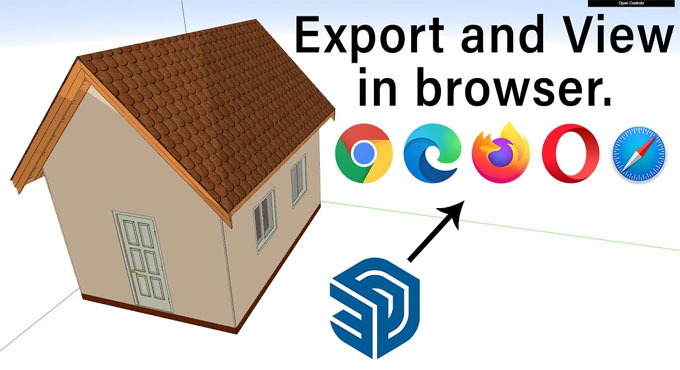Exporting Google SketchUp Models into WebGL as JSON Points

In the realm of 3D modeling and web development, Google SketchUp stands out as a popular tool for creating intricate and immersive models. However, while SketchUp provides powerful features for modeling, exporting these creations into WebGL for web-based display can be a daunting task for many users.
Fortunately, with the right approach and understanding, this process can be simplified and streamlined, opening up a world of possibilities for showcasing SketchUp creations on the web.
Bridging the Gap between SketchUp and WebGL
Google SketchUp has long been revered for its intuitive interface and robust modeling capabilities. From architectural designs to intricate 3D scenes, SketchUp enables users to bring their visions to life with relative ease. However, when it comes to sharing these creations online, traditional formats often fall short in terms of interactivity and accessibility.
This is where WebGL comes into play. WebGL, or Web Graphics Library, is a JavaScript API that enables high-performance 3D graphics within compatible web browsers, without the need for additional plugins. By harnessing the power of WebGL, SketchUp models can be transformed into immersive web experiences, allowing users to explore and interact with them in real-time.
Understanding the Export Process
Before diving into the export process, it is essential to understand the underlying principles and requirements. SketchUp models are typically created using a combination of polygons, vertices, and textures, which need to be converted into a format compatible with WebGL.
JSON (JavaScript Object Notation) emerges as a suitable candidate for representing 3D models in a web-friendly format. By exporting SketchUp models as JSON points, we can preserve the geometric information and textures necessary for rendering them in a web environment.
Step 1: Prepare Your SketchUp Model
The first step in the export process is to ensure that your SketchUp model is properly prepared. This involves optimizing the geometry, organizing components, and applying textures where necessary. Keep in mind that complex models with a high level of detail may require additional optimization to ensure optimal performance in a web-based environment.
Step 2: Install and Configure Plugins
To export SketchUp models into WebGL-compatible JSON points, we'll need to utilize plugins that facilitate this conversion process. One such plugin is the "SketchUp to WebGL Exporter," which streamlines the export process and generates the necessary JSON files.
After installing the plugin, take some time to configure the export settings according to your preferences. This may include adjusting texture compression, specifying output resolution, and defining the desired level of detail for the exported model.
Step 3: Export to JSON
With the plugin installed and configured, you're ready to export your SketchUp model to JSON format. Simply select the desired model or scene within SketchUp, navigate to the export options, and choose the JSON format. The plugin will then process the model and generate the corresponding JSON files, including geometry data, textures, and material properties.
Step 4: Embedding into Web Environment
Once the JSON files have been generated, it's time to integrate them into a web environment using WebGL. This typically involves creating a web page or application that utilizes the WebGL API to load and render the 3D model. By referencing the exported JSON files and implementing the necessary JavaScript code, you can create an interactive web experience that showcases your SketchUp model in all its glory.
Best Practices and Considerations
While the export process outlined above provides a general framework for converting SketchUp models into WebGL-compatible JSON points, there are several best practices and considerations to keep in mind to ensure optimal results.
Optimization for Performance
Performance optimization is crucial when exporting SketchUp models for web-based display. This involves minimizing the file size of the JSON data, optimizing textures, and reducing the complexity of the geometry. By prioritizing performance optimization, you can ensure that your WebGL-enabled web experiences remain responsive and accessible across a wide range of devices and platforms.
Texture Compression
Textures play a significant role in enhancing the visual quality of SketchUp models. However, large texture files can significantly impact performance and load times in a web environment. To mitigate this issue, consider employing texture compression techniques such as image compression and mipmapping. By reducing the size of texture files while maintaining visual fidelity, you can strike a balance between performance and visual quality in your WebGL-enabled web experiences.
Cross-Browser Compatibility
When developing WebGL-enabled web experiences, it is essential to consider cross-browser compatibility.
While modern web browsers generally support WebGL, there may be variations in performance and compatibility across different platforms and devices. To ensure a consistent experience for all users, thoroughly test your WebGL applications across multiple browsers and devices, and implement fallback options where necessary.
User Interaction and Accessibility
Interactivity is a hallmark of WebGL-enabled web experiences, allowing users to explore and interact with 3D models in real-time.
When designing your web-based applications, consider incorporating intuitive controls and navigation mechanisms that enable users to manipulate the camera view, zoom in on details, and interact with interactive elements within the scene. Additionally, ensure that your WebGL applications are accessible to users with disabilities by providing alternative navigation options and adhering to web accessibility standards.
Embracing the Power of WebGL
In conclusion, exporting Google SketchUp models into WebGL as JSON points opens up a world of possibilities for showcasing 3D creations in web environments.
By following the steps outlined in this article and adhering to best practices and considerations, you can seamlessly integrate SketchUp models into web-based applications and create immersive and interactive experiences that captivate and engage users.
Video Source: TutorialsUp
As technology continues to evolve, the convergence of 3D modeling and web development holds immense potential for pushing the boundaries of creativity and innovation. By embracing the power of WebGL and leveraging tools such as SketchUp, designers and developers can unlock new avenues for expression and storytelling in the digital realm.



